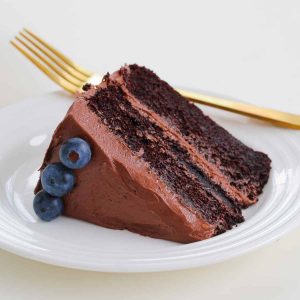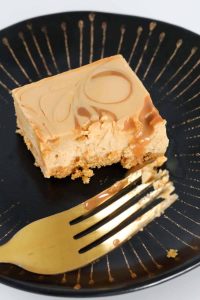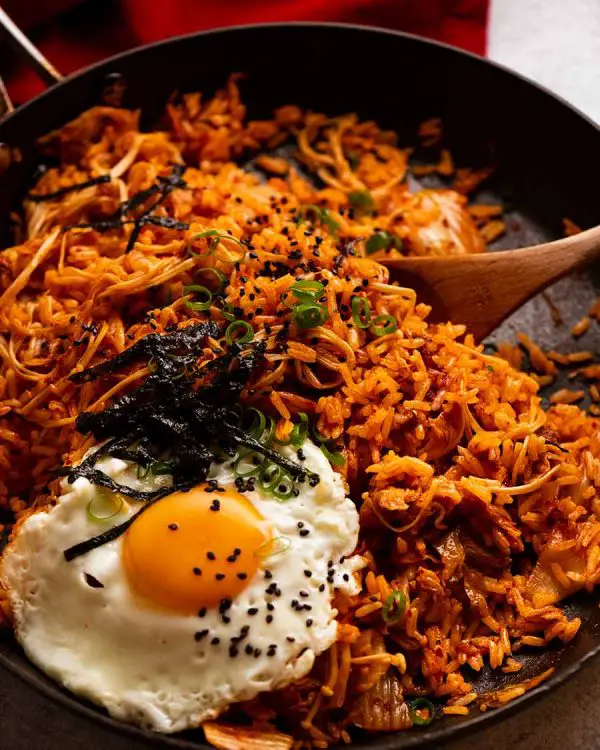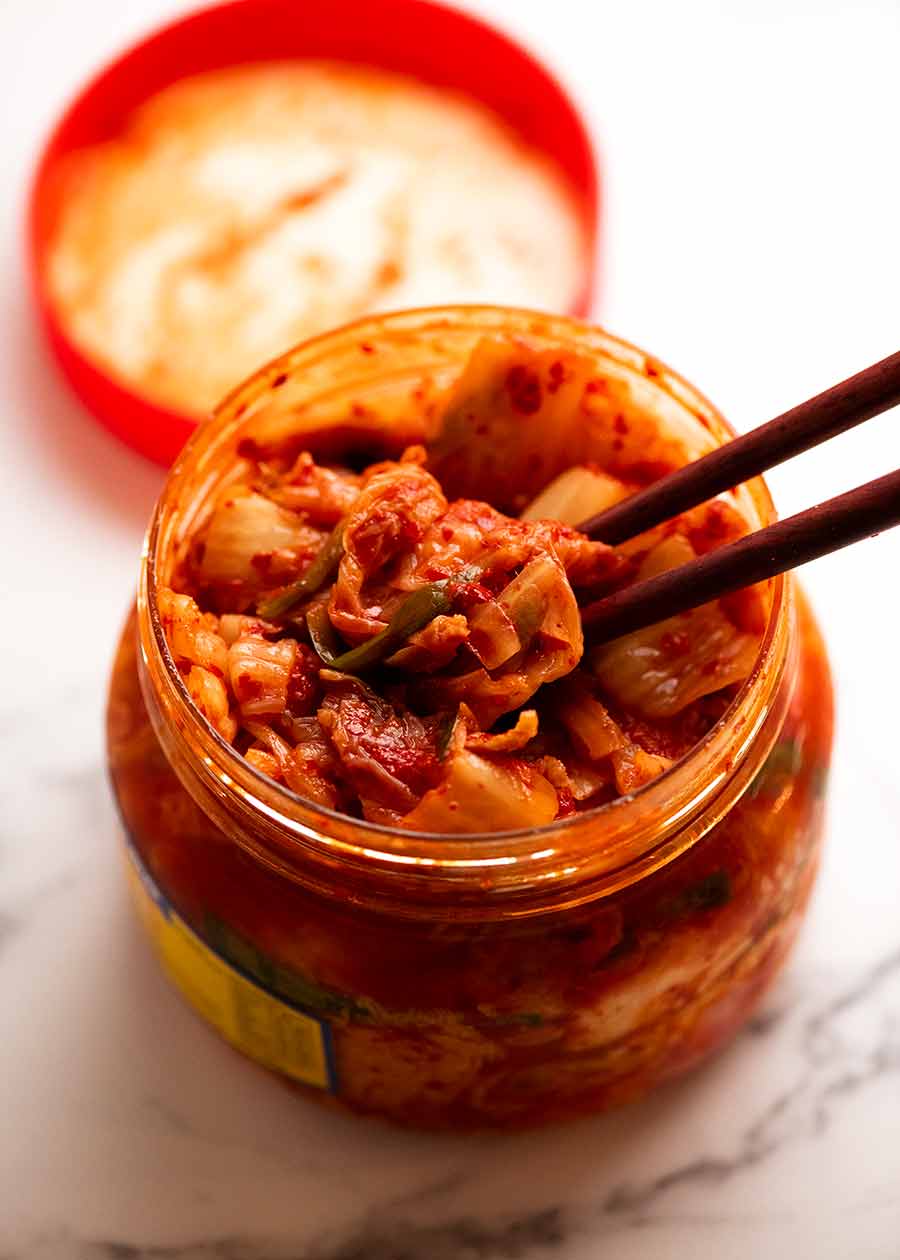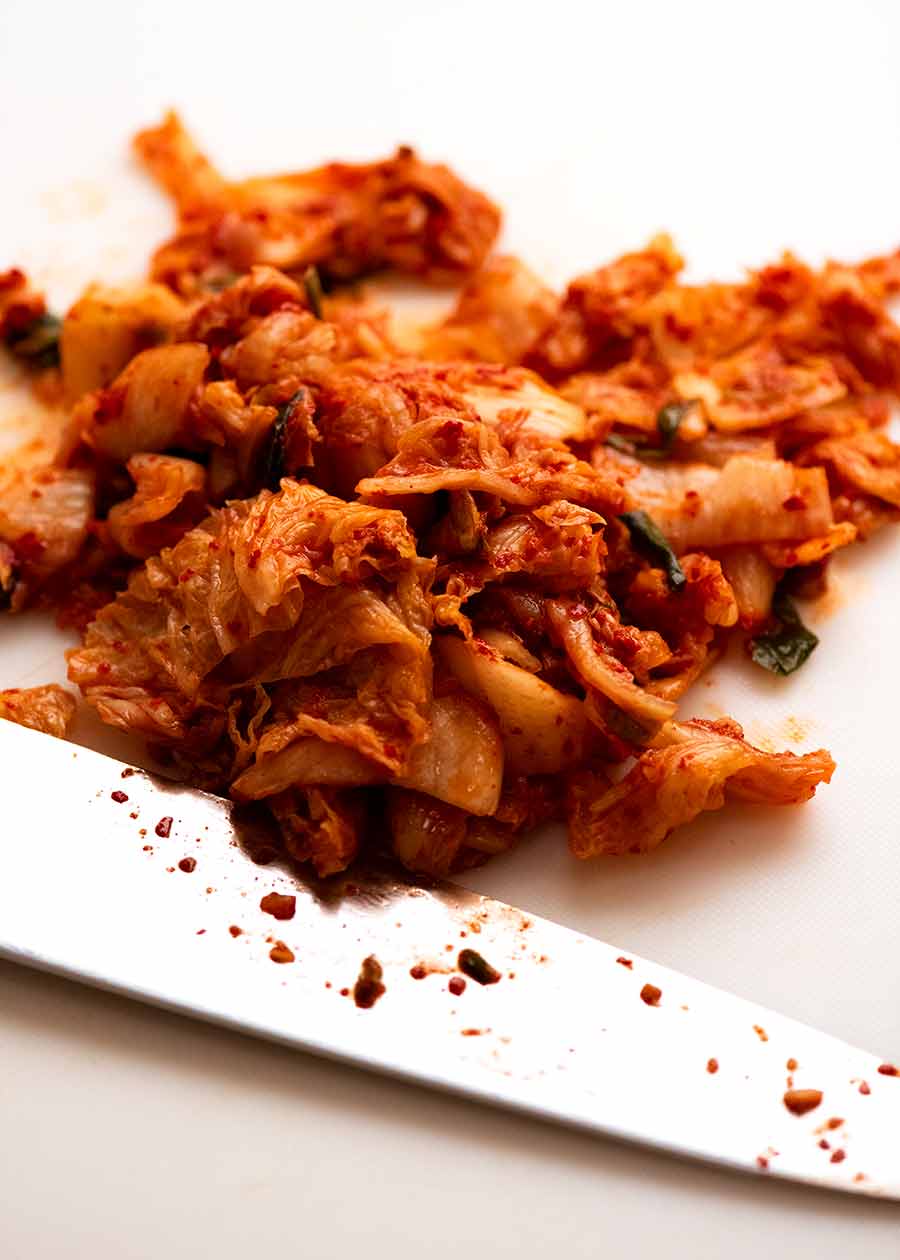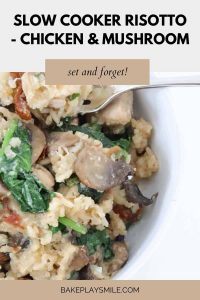This post Kimchi Fried Rice has been updated in 2022.
Don’t be intimidated by the fiery red colour of Kimchi Fried Rice. It actually isn’t that spicy! But it’s certainly loaded with flavour, even more than its Chinese counterpart. It’s a wonderful side dish or main course for Korean cuisine. And it’s a satisfying meal in itself!
Kimchi Fried Rice
Kimchi Fried Rice is just as popular in Korea as Chinese Fried Rice in China. Every household makes it, and it’s a thrifty comfort dish that makes use of leftover cooked rice and kimchi from the fridge. To keep it interesting, you can always add more ingredients to your pantry.
This Korean dish of fiery-red rice is more bark than it is bite! While it is full-flavoured, it is not nearly as blow-your-head-off-spicy as one might expect.
Though having said that, if spicy is your thing, it’s very simple to dial up the spicy factor until you go cross-eyed!
What does Kimchi Fried Rice taste? Well … Kimchi. 🙂There’s more! Kimchi Fried Rice sauce is made from the juices of a jar kimchi and plus gochujangThe Korean soy bean chilli paste is a common ingredient in Korean cooking.
This is a great recipe for fried rice lovers. It’s one of the more intensely flavoured fried rice dishes, which is right up my alley. I’m all for it. Kapow flavours!
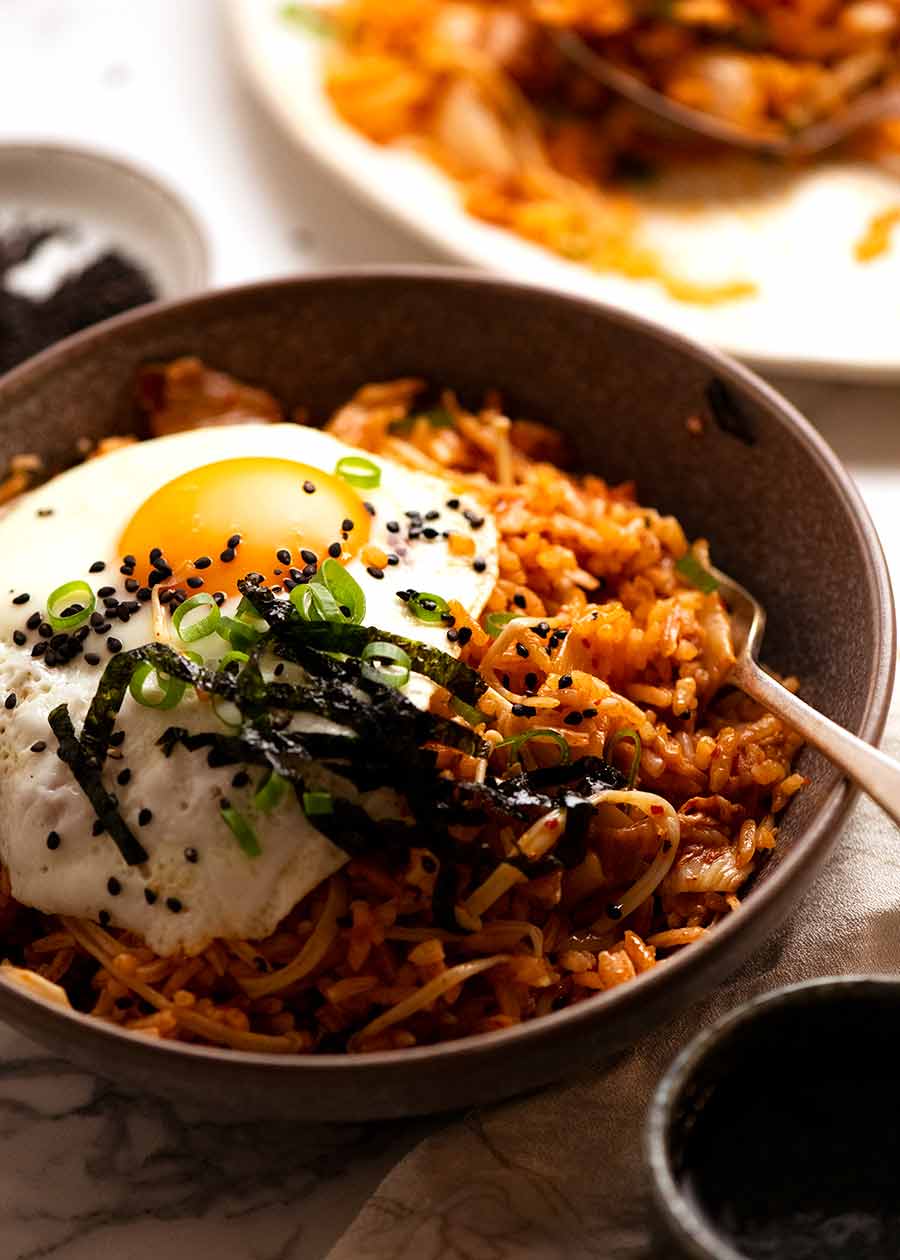
What’s in Kimchi Fried rice?
Here’s what you need to make Kimchi Fried Rice:
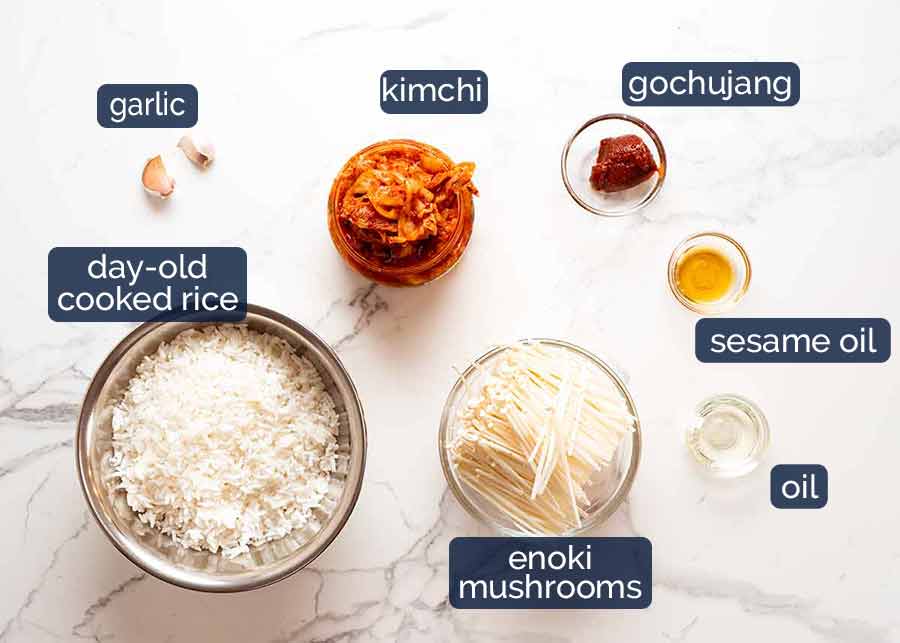
-
Kimchi – Kimchi, also known as fermented cabbage and spicy, is pickled cabbage. It’s pretty widely availably these days even in everyday grocery stores, especially with the whole fermentation trend amongst the healthy food crowd.
Fashion aside, stick with the tried-and-true Korean kimchi brands instead of trying to be trendy. Kimchi can be made in different ways, so it is worth looking at Asian stores. Kimchi is usually fresher and has a better flavor. In this recipe, I’m using Paldo brand.
-
Rice – Use day-old cooked rice that’s been refrigerated. Have you got frozen rice? Why not? Rice freezes perfectly and it’s a handy to have a stash ready to go. It’s an Asian thing. 😇
Are you having difficulty cooking rice? Here’s how I make it. This is a game-changer, especially for those who have struggled to cook rice on the stove.
Types of rice – For the neutralest flavour base, any plain white rice will work, regardless of whether it is long, medium, or short grain. Other rices that have more flavour, such as basmati, jasmine, brown, and others, will work well, but will not add any distinctive flavour to the dish.
-
Enoki mushrooms – While you’ll find every Korean household has their own standard inclusions for Kimchi Fried Rice (I’ve even heard of Spam hamBeing a regular!You will often find enoki mushrooms in Korean restaurants. The recipe card notes provide substitutions;
-
Gochujang – A soy bean-based Korean chilli paste that is packed with umami(savoury flavor), used in Korean cooking to add heat, flavour, and rich colour. A dollop of this can save any (Asian) dish that you feel is missing “something” and it lasts almost forever in the fridge. It’s spicy, but we don’t use much, just 1 tablespoon.
Where to look for it:You can find it these days in the Asian section at major Australian grocery stores, Woolworths and Coles. Other than that, Asian and Korean stores.
Also used in: Momofuku Pork Bossam, Bibimbap (Korean Rice Bowl), Spicy Korean Pork Stir Fry.
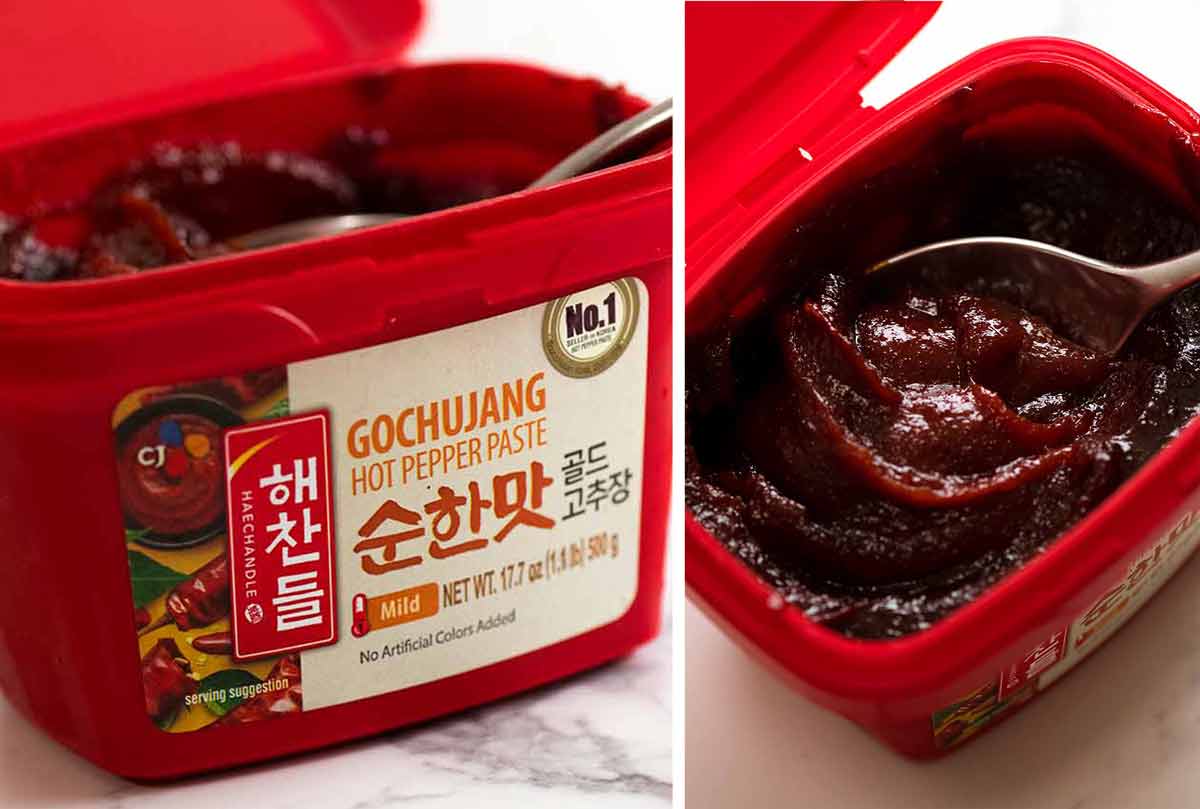
-
Garlic – It would be an understatement to say Koreans love their garlic. Kimchi Fried Rice could not happen without garlic!
-
Sesame oil – Koreans also love sesame oil!
Kimchi Fried Rice: How to Make It
Kimchi Fried Rice has the juice of Kimchi and a dash of gochujang to give it a kick. Really, don’t skip the gochujang. It would be like making Chinese Fried Rice sans soy sauce. Just, no!
Part 1: Prep the Kimchi
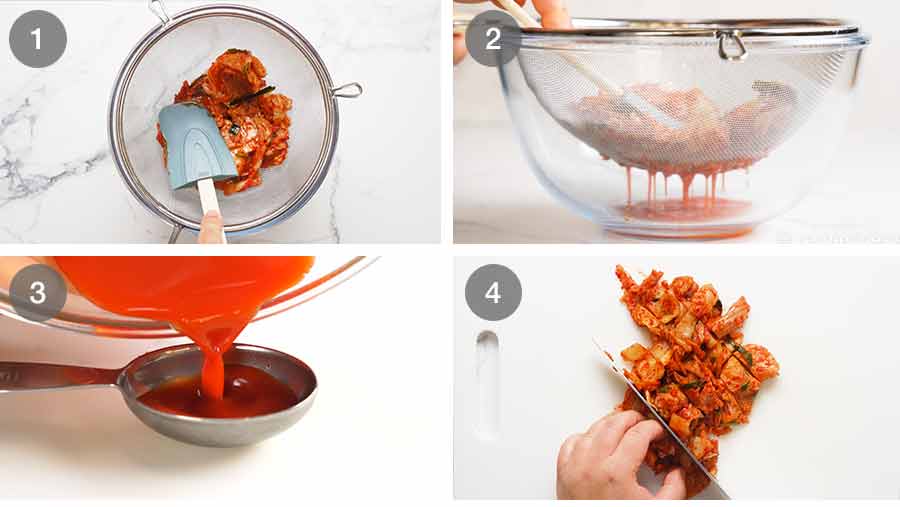
-
Additional juice from kimchi – Measure out 1 packed cup of kimchi, then either press through a sieve to extract as much juice as possible OR just grab handfuls and squeeze it out. Although I usually do the former, I thought it would be more respectful to use a sieve when sharing this recipe.
-
This step has two purposes. – To extract the kimchi juice which we use as the sauce for the fried rice, and to remove water from the kimchi so the fried rice doesn’t go soggy;
-
Take out1/4 cup kimchi juice. If you’re struggling to get this much out of the 1 cup of kimchi you measured, if you’re still short, steal some more out of the kimchi jar or squeeze more cabbage!
-
Kimchi: Chop into 2cm / ⅘” pieces – Not too fine, we want the chunks in the fried rice.
Part 2: Making Kimchi Fried Rice

-
Cook enoki mushrooms – Most recipes will have you cook the enoki mushrooms with the rice. You get a better result by cooking it separately so it doesn’t go soggy, and nor does it get weighed down by too much of the rather intense Kimchi Fried Rice sauce.
It tastes great when seasoned with sesame oil, garlic and some salt.
-
Set aside – It takes barely a minute to start wilting in the pan. You can then transfer the mixture to a plate.

-
Sauté garlic with gochujang – This takes the raw edge off the gochujang, and removes some of the excess water to keep the fried rice from going soggy. This enhances the gochujang taste.
-
Kimchi – Next, we add the kimchi and cook it for a minute to drive off any excess moisture and warm it through. Kimchi does not need to be cooked, we just don’t want cold bits of kimchi in our fried rice!

-
Add rice;
-
Add kimchi juice;

-
Toss well – Toss the rice well to ensure all the flavours coat the rice evenly. You want to make sure the kimchi gochujang coating is not lost through the rice.
-
Add enoki mushroomsToss the pieces through and back in. You’re done!
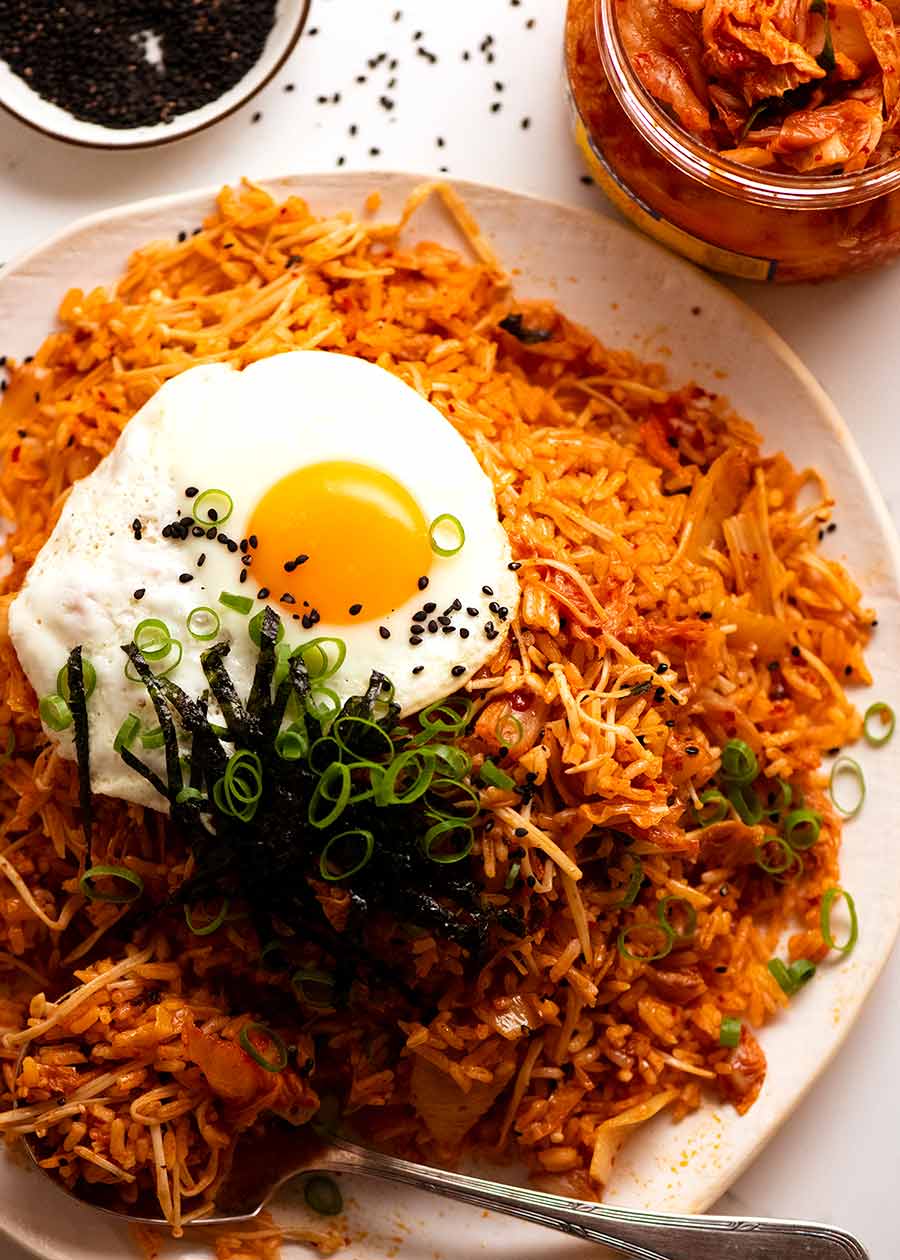
Optional toppings: Fried egg & noriStrips
If you’re serving Kimchi Fried Rice as a side dish for Korean mains, especially things that are a bit saucy, then it’s fine to serve it unadorned.
However, if you’re serving it as a meal, I definitely recommend topping it with a fried egg, sunny side up! This traditional topping is Kimchi Fried Rice. The runny yolk acts as a sauce.
Other traditional garnishesThe following are examples of visual effects that have more to do with flavour than the actual taste:
-
Crispy noriSeaweed strips – You can buy roasted, crispy noriSeaweed is sold in small packets that are just cut into tiny batons. If you don’t want to use nori, you can just use normal nori. It’s really not a big part of the eating experience, it’s more for visual;
-
Green onions – Just finely sliced for a nice splash of fresh green colour; and
-
Black sesame seeds – The black colour pops against the red rice and the egg! But again, it’s not a big deal to skip it.
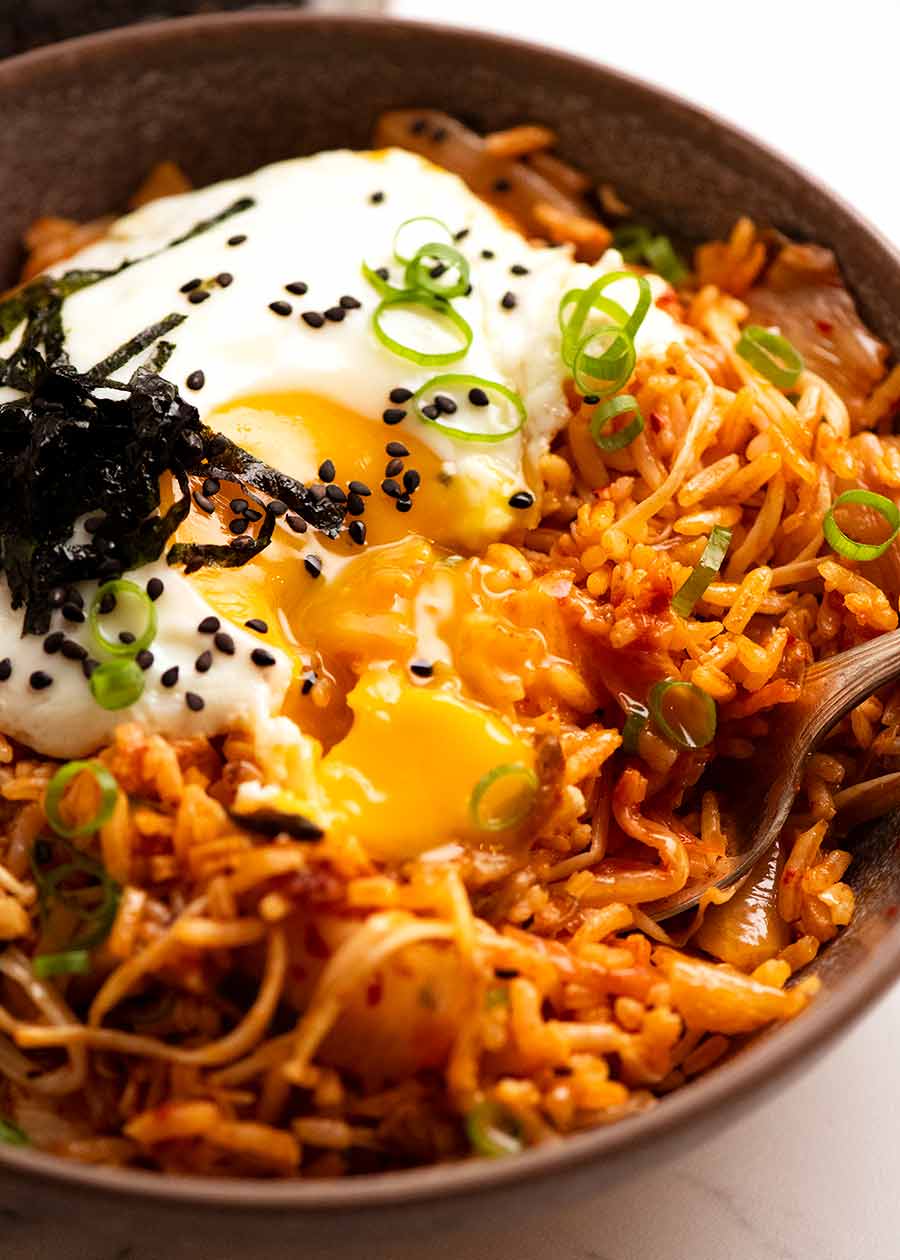
Kimchi Fried rice:
Here are some ideas for Kimchi Fried Rice
-
Side dish for all things Korean
-
In fact, it’s an Asian side dish. This is a side dish that can be used alongside stir fries or Chinese Crispy Pork Belly.
-
Serve light meals like Egg Foo Young or Spring Rolls with Siu Mai and Sticky Chinese Wings.
-
Complete the meal by topping it with the eggs
-
Place it all on a hotplate at the end a Korean home barbecue.
-
Use it to stuff into Korean Lettuce Wraps – try it with Momofuku Pork Bossam. Epic!
Enjoy! – Nagi x
The Spicy Side of Living: Korean Recipes
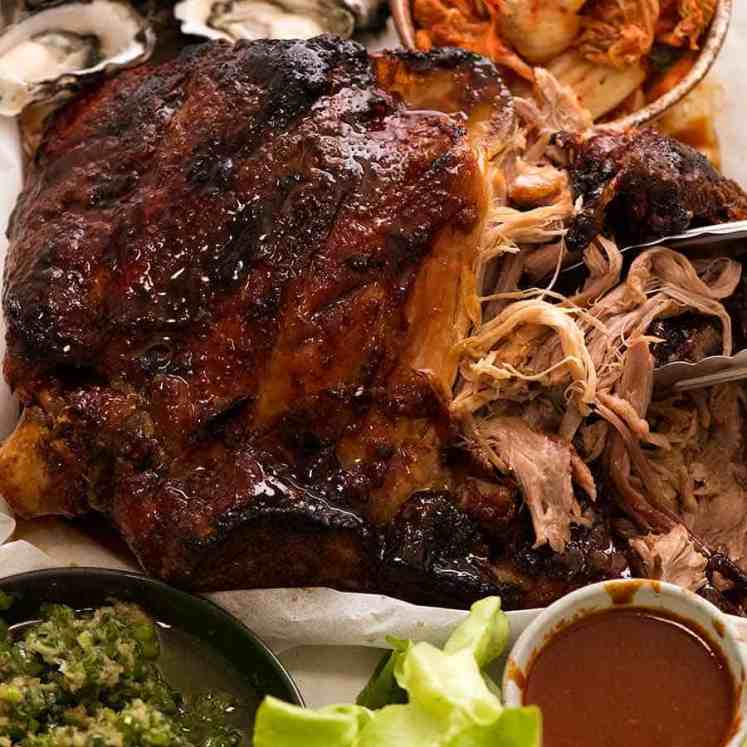
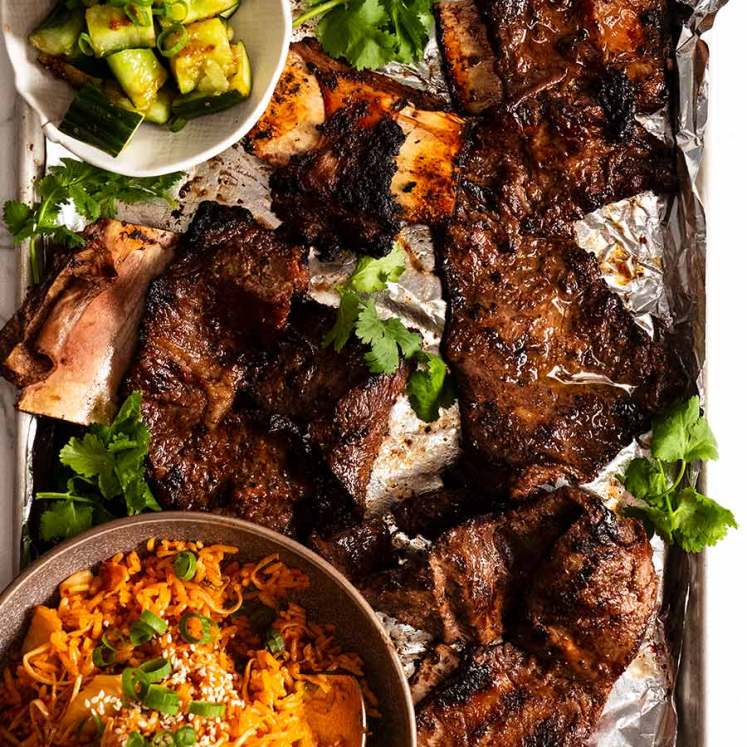
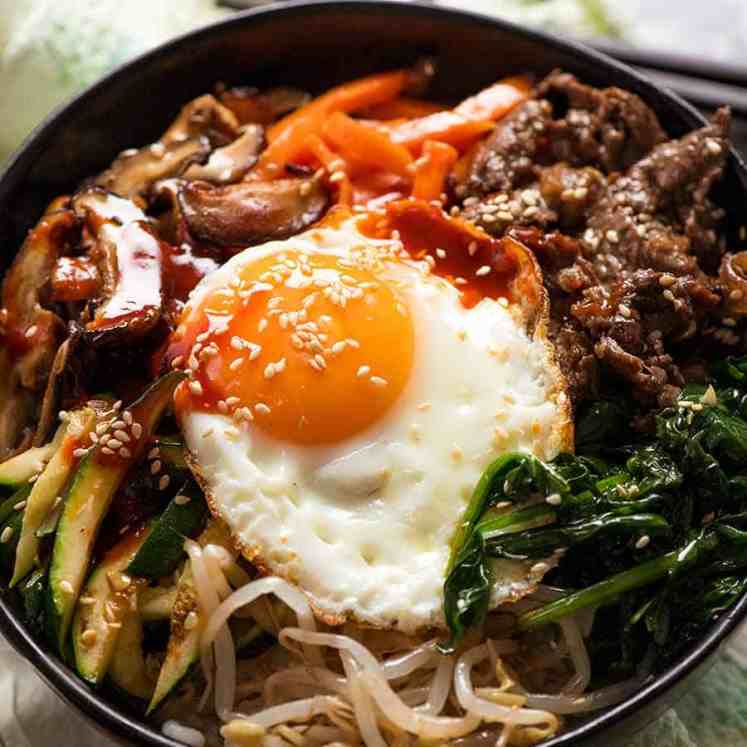
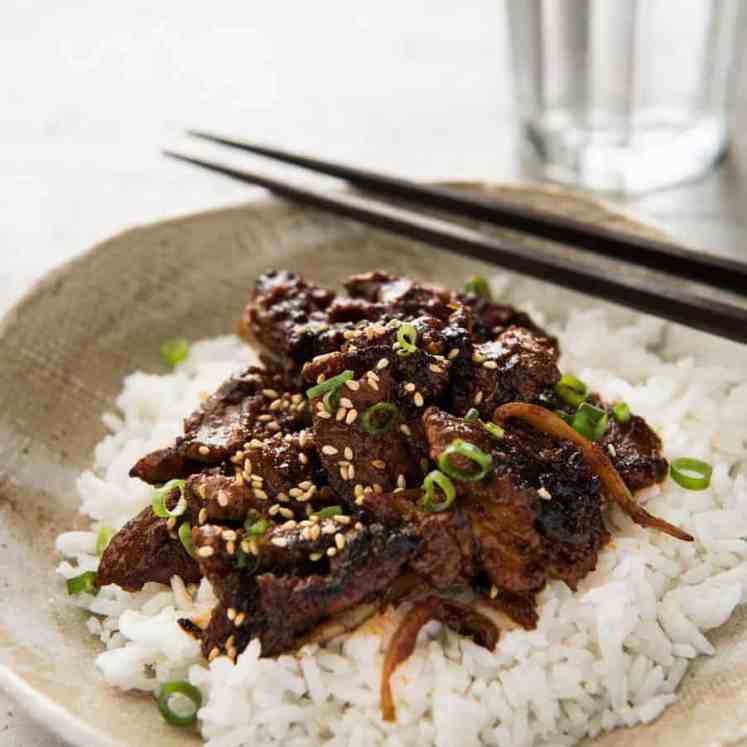
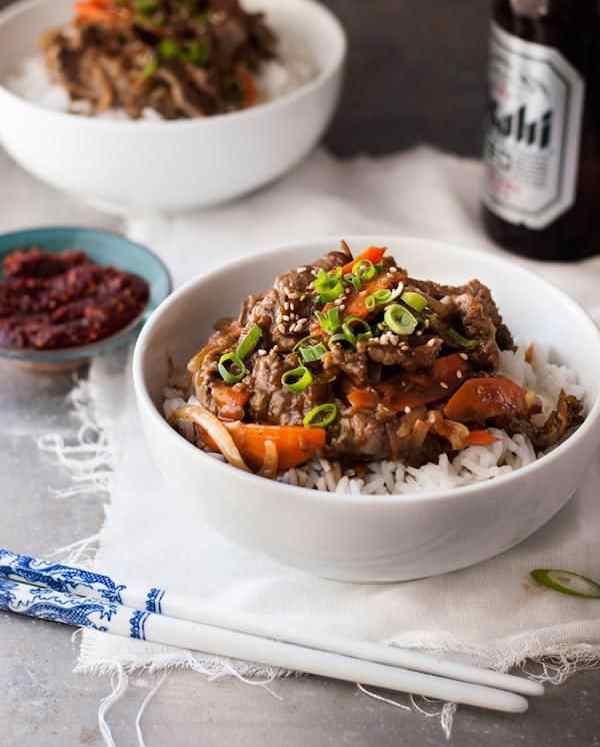

How to make it
Do you want more?Follow me on Facebook, Pinterest, and Instagram to get the most recent updates. Subscribe to my newsletter

Kimchi Fried Rice
Don’t panic! It’s not as spicy as you think and you can easily adjust the heat.
Serve with all things Korean or Asian. You can also serve it as a main course with a fried or steamed egg.
Ingredients
- 2 tsp Sesame oil Toast, separate (1 tsp +1 tsp).
- 2 Garlic cloves Finely chopped
- 200g/7oz enoki mushrooms (Note 1)
- 1 tbsp Oil Vegetable, peanut, or canola
- 1 tbsp gochujang (Korean chilli paste, Note 2)
- 1 Cup Kimchi packed (Note 3)
- 1/4 Cup kimchi juice Taken from the kimchi (Note 3).
- 3 Cups Cooked Note 4) – Day-old white rice
Garnishes:
- Fried egg , runny yolk, sunny-side up
- Black sesame seeds
- Green onions Finely sliced
- Crispy seaweed strips (Note 5)
Instructions
-
Strain kimchi juice – Place kimchi in a sieve set over a bowl. To extract as much juice possible, press down hard. We need the juice to make the sauce. The juice will also help reduce the wetness in the kimchi, so the rice won’t get soggy.
-
Take kimchi juice – Measure out 3 tablespoons of the kimchi juice and set aside. If you are short, note 3
-
Cook enoki mushrooms – Heat 1 tsp sesame oil in a large non-stick pan over medium-high heat. Add the enoki mushroom, 1/2 tsp garlic and a pinch of salt. Cook for 1 1/2 to 2 minutes or until tender. Transfer to a plate.
-
Garlic and gochujang – Return pan to the stove. Add oil. Cook for 20 seconds, stirring frequently. Add gochujang and cook for 30 seconds until it dries out a bit – just move it around in a lump, breaking it up a bit as you can.
-
Kimchi – Add kimchi and cook for 1 minute, just to heat it through (kimchi doesn’t need to be cooked) and drive off any excess moisture.
-
Add rice and kimchi juice –Toss in the rice and kimchi juice. Continue to stir for about 1 1/2 minutes, until the rice turns a deep red color. Mix the gochujang with the kimchi well and toss the rice.
-
Enoki mushrooms, 1 tsp sesame olive oil – Add the enoki mushroom and 1 teaspoon of remaining sesame oils. Stir through the rice.
-
Serve, Topped with garnishes of your choice
Notes for Recipes
2. Gochujang – Korean soy bean chilli paste, it adds a ton of umami (savoury flavour) and spice into anything! Find it in large grocery stores in the Asian aisle (Woolies, Coles, Harris – for Aus), or Asian / Korean grocery stores. It lasts “forever” in the fridge. It can also be used for Korean Pork Bossam and Bibimbap, as well as Korean Pork Stir Fry.
You may find Gochujang in various levels of chilli heat. This is usually indicated on the label. The milder one is recommended, as it’s already quite spicy.
You can make your Kimchi Fried Rice more spicy by adding 50% more gochujang. You can let the flavour and salt dominate the dish. even more spiciness, I’d suggest you add chilli powder from here.
3. Kimchi – A Korean staple, this is pickled fermented vegetables. We use cabbage as the most commonly available. You can find it in almost every grocery store. I used Paldo brand Kimchi here.
If your 1 cup of kimchi doesn’t yield enough juice, spoon out some from the jar or just squeeze extra from more cabbage!
4. Day-old, cooked rice – White rice is best (and traditional). It must be day-old so it’s dry and crumbly, to avoid mushy fried rice. You may need it in an emergency situation. Put the rice in a pan, then let it cool on a tray.
5. Crispy seaweed / nori strips – Buy it, or skip it. It’s not a big deal for this dish, it’s more for visuals!
6. Reheating and storage – Fried rice keeps very well, especially one without meat. Keep the rice in a sealed container for up to five days in the refrigerator. You can reheat it by adding a splash of water to a microwave. While it can be frozen, but it’s not recommended especially when it’s so quick to make.
7. NutritionAssume 5 servings. This does not include toppings.
Nutrition Information:
Do you love spicy Asian food?
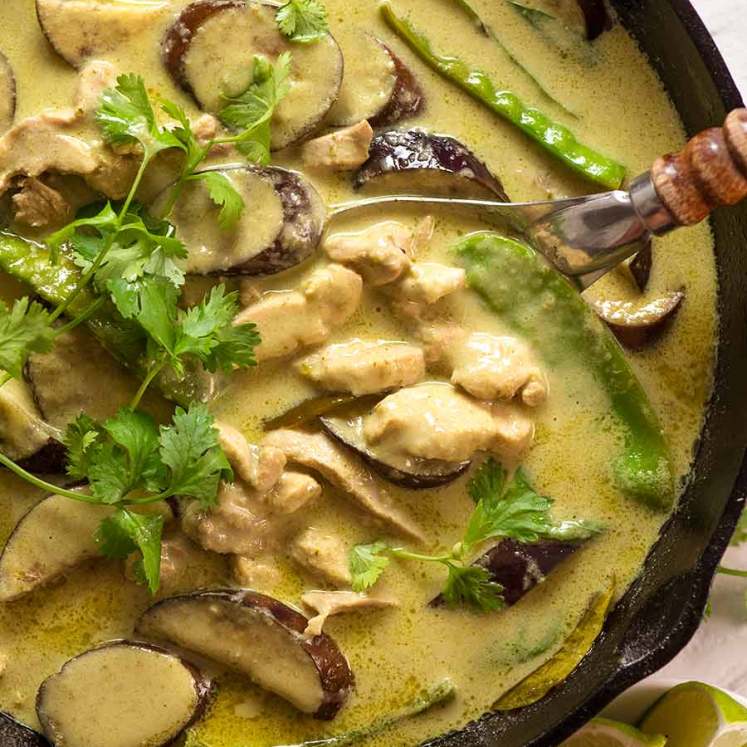
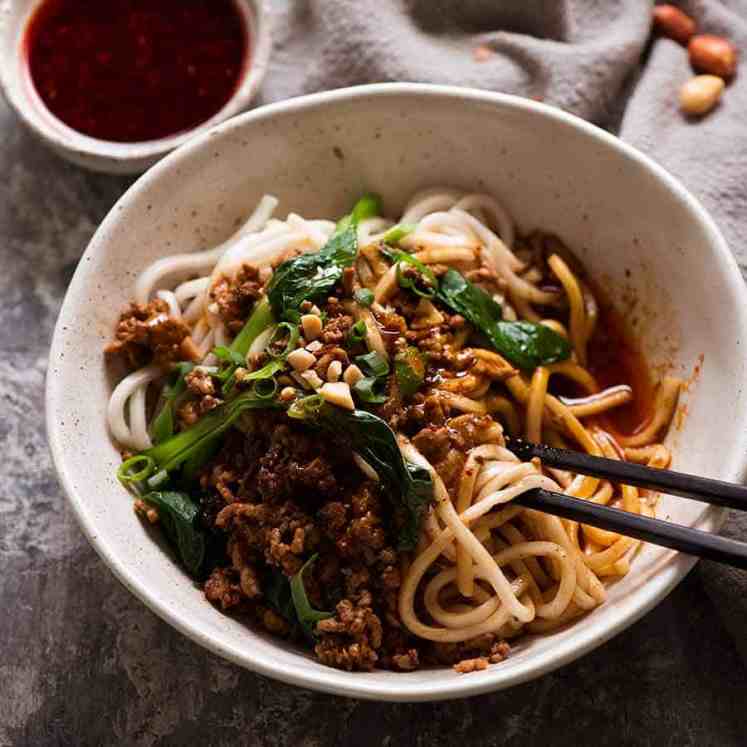
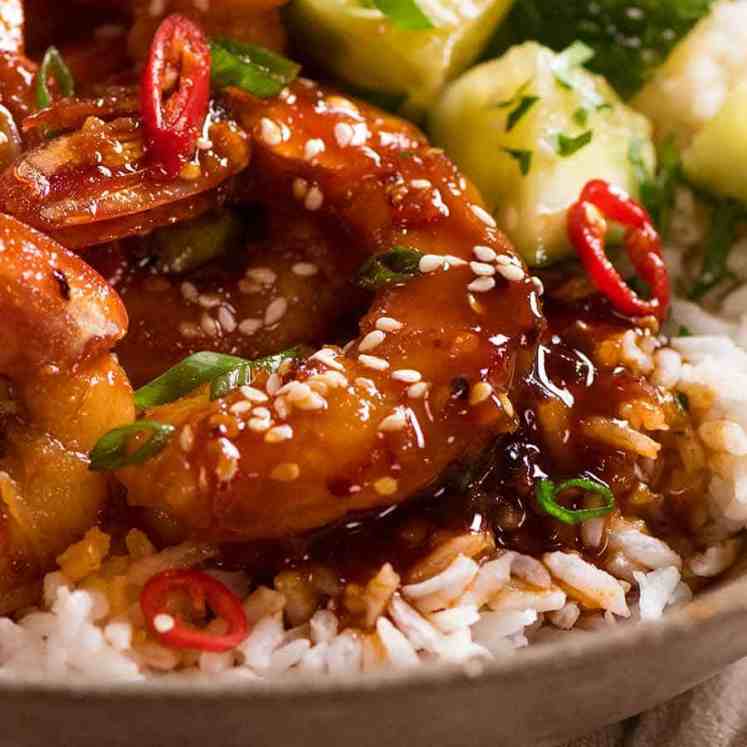
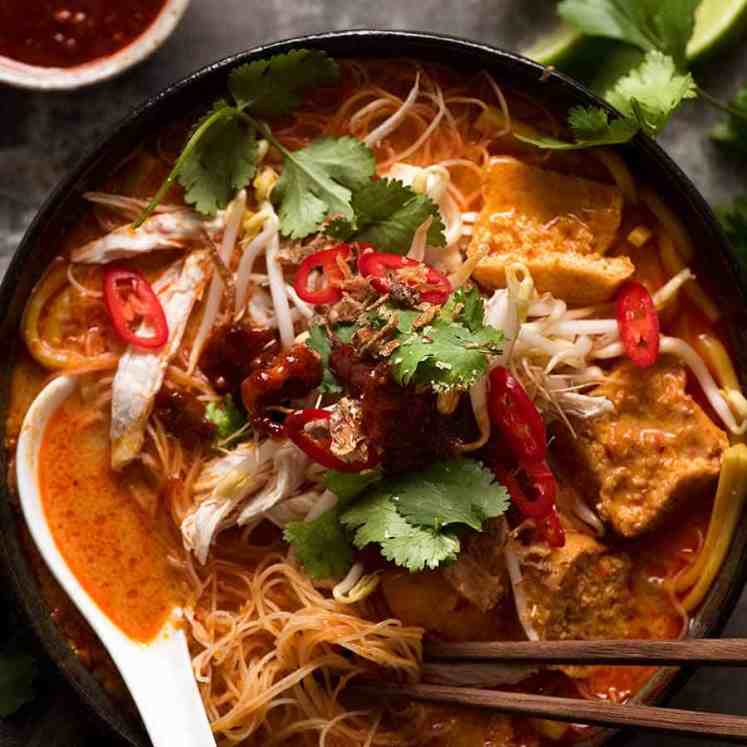
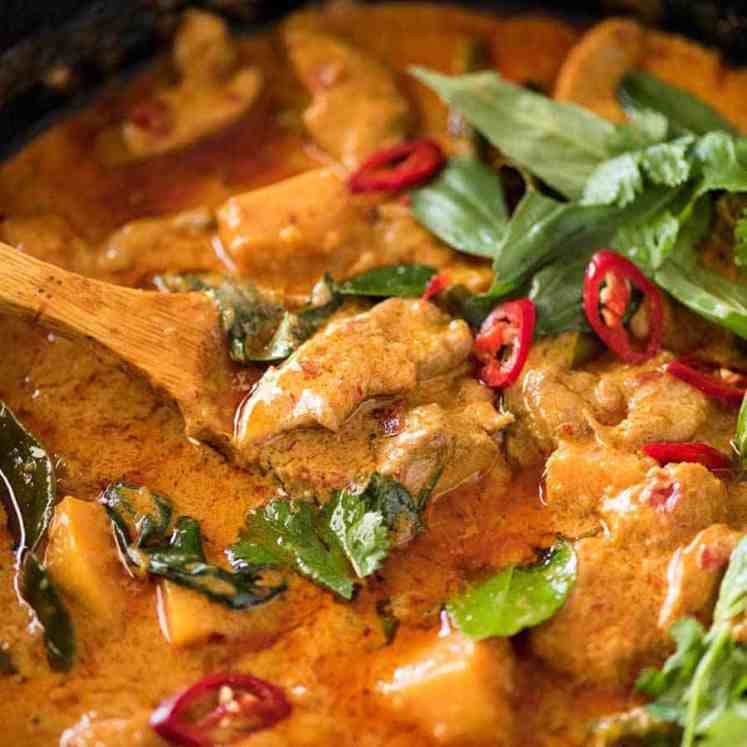
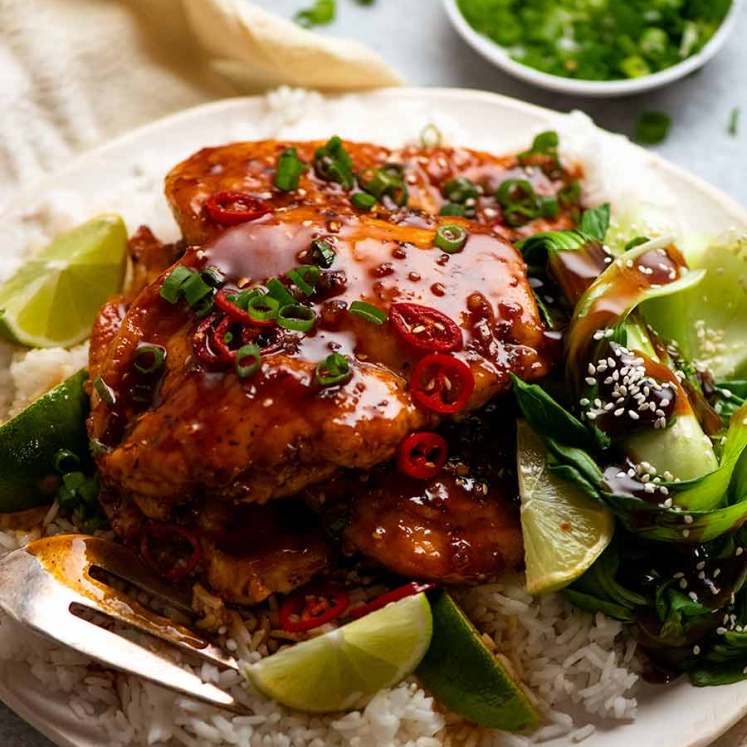
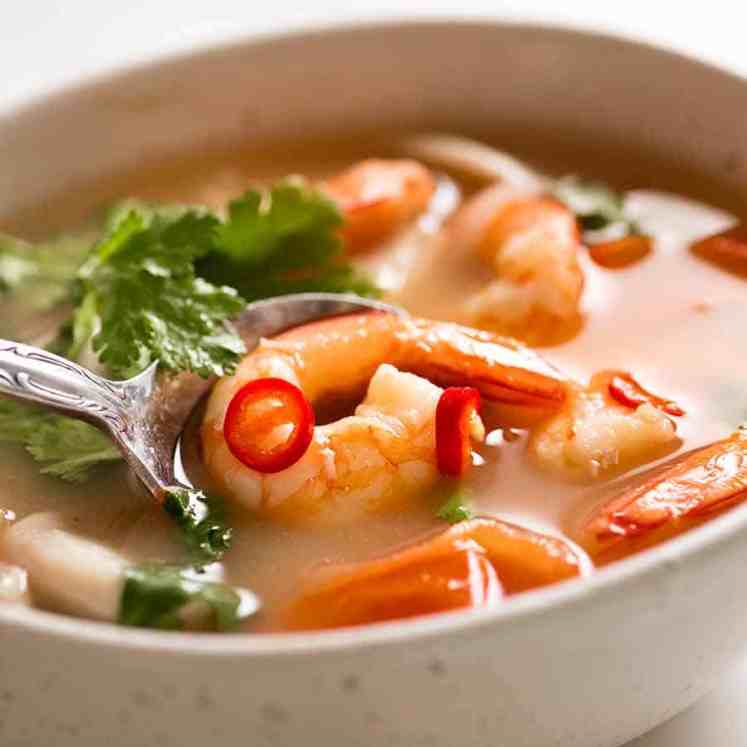
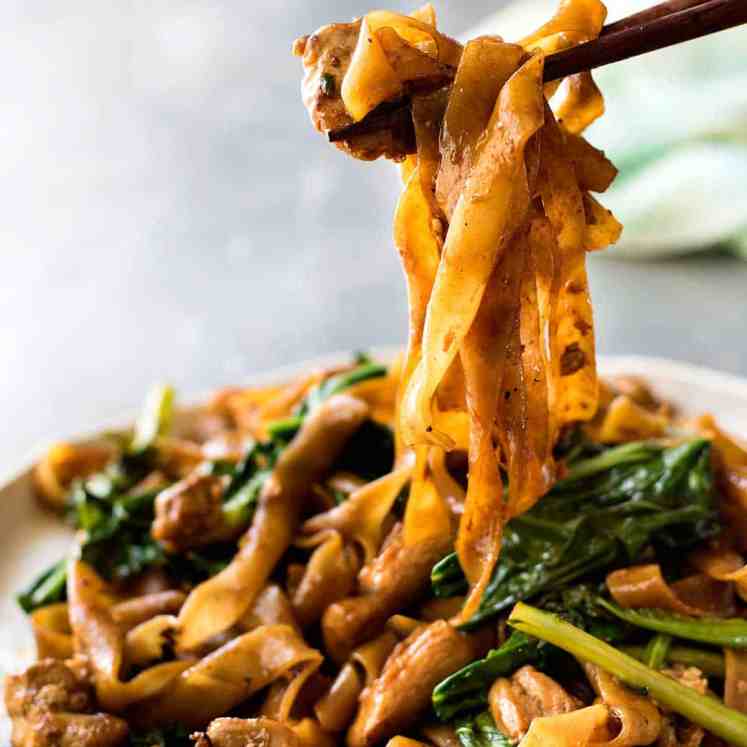
Dozer Life
Not even a little rain disrupts Dozer’s beach schedule.






